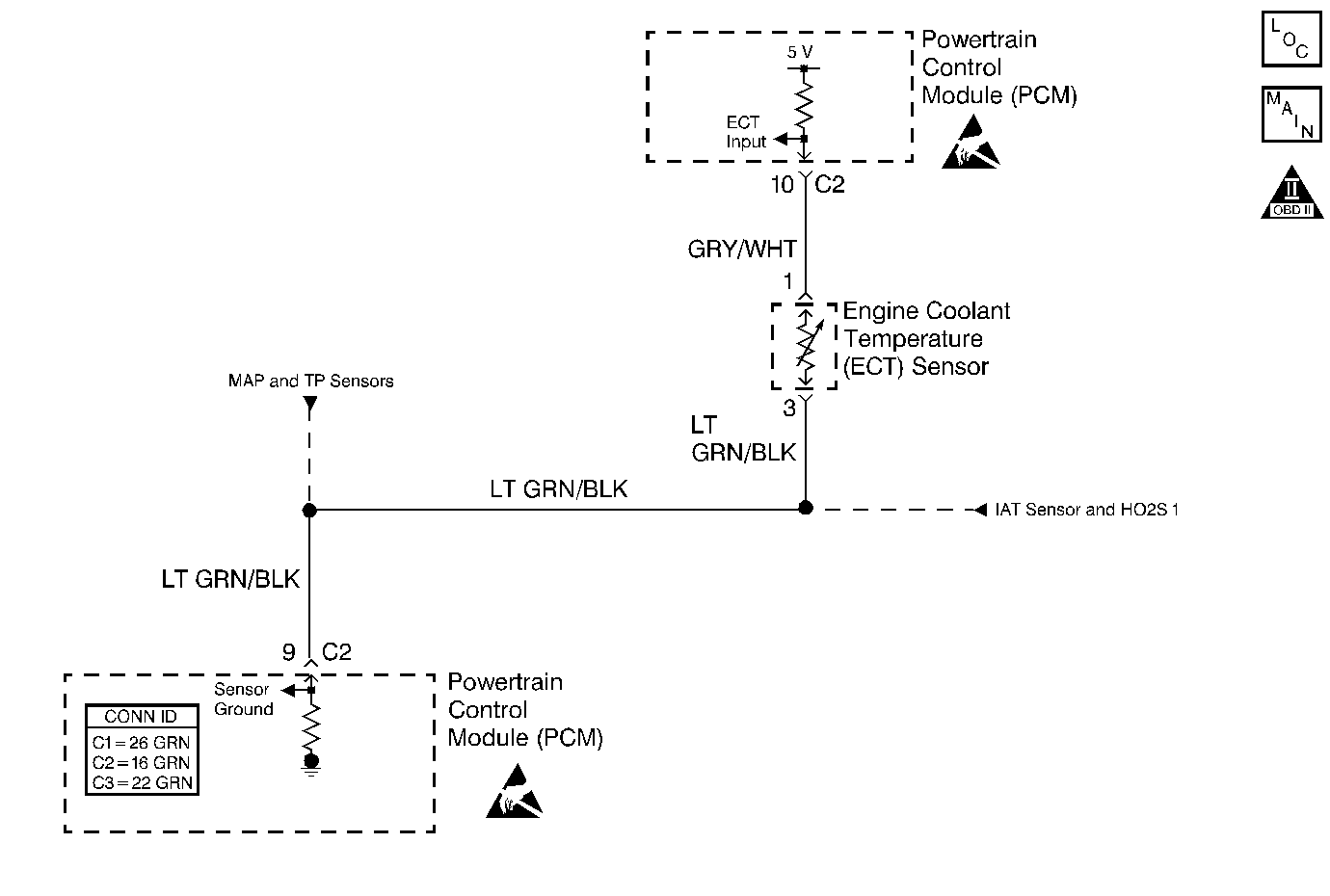
Circuit Description
The engine coolant temperature (ECT) sensor is a thermistor. A thermistor is a resistor whose value varies with temperature. If the engine coolant temperature is low, the ECT sensor's resistance is high. If the engine coolant temperature rises, the ECT sensor's resistance decreases. The ECT sensor is wired in series with a fixed resistor in the powertrain control module (PCM). The PCM applies 5 volts to the ECT sensor. The PCM monitors the voltage across the ECT sensor and converts the voltage into a temperature reading. The PCM receives a high voltage if the coolant temperature is low, and a low voltage if the coolant temperature increases.
Conditions for Running the DTC
The ignition is ON.
Conditions for Setting the DTC
| • | The ECT sensor signal indicates that the engine coolant temperature is more than 119°C (246°F). |
| • | The above conditions are met for at least 0.5 seconds. |
Action Taken When the DTC Sets
| • | The PCM illuminates the malfunction indicator lamp (MIL). |
| • | The PCM records the operating conditions at the time that the diagnostic fails. This information is stored in the Freeze Frame buffer. |
| • | The PCM enters the Fail-Safe Function and assumes the engine coolant temperature is 80°C (176°F). The idle speed feedback control and the A/C control stop. The PCM turns ON the engine cooling fan. |
Conditions for Clearing the DTC
| • | The MIL turns OFF after 3 consecutive trips during which the diagnostic runs, and a fault is not detected. |
| • | A History DTC clears after 40 consecutive warm-up cycles without a fault. |
| • | Use the Clear DTC Information function of the scan tool, or disconnect the PCM battery feed in order to clear the DTC. |
Diagnostic Aids
Check for any of the following conditions:
| • | Using the Temperature vs Resistance table, check the ECT sensor at various temperature levels, and evaluate the possibility of a shifted sensor. A shifted sensor could result in a driveability complaint. Refer to Temperature Versus Resistance . |
| • | The ECT sensor reading should rise to about 95°C (203°F) after the engine start up. The reading should stabilize when the thermostat opens. Verify that the engine is not overheating and has not been operated within conditions that could create an overheating condition. |
| • | The engine cooling fan will turn ON when the DTC sets. |
An intermittent complaint may be caused by a fault in the ECT sensor electrical circuit. Inspect the wiring harness and the components for any of the following conditions:
| • | Backed out terminals. |
| • | Incorrect mating of terminals. |
| • | Broken electrical connector locks. |
| • | Incorrectly formed terminals or damaged terminals. |
| • | Faulty terminal-to-wire connections. |
| • | Physical damage to the wiring harness. |
| • | A broken wire inside the insulation. |
| • | Corrosion of electrical connections, of splices, or of terminals. |
If DTC P0117 cannot be duplicated, the Freeze Frame data can be useful in determining the vehicle operating conditions when the DTC first set
Test Description
The numbers below refer to the step numbers in the diagnostic table.
-
The Powertrain OBD System Check prompts the technician to complete basic checks and to store the freeze frame data on the scan tool if applicable. This creates an electronic copy of the data that was taken when the fault occurred. The information is stored in the scan tool for later reference.
-
This step checks the current ECT sensor reading.
-
This step determines if the fault is present.
-
This step determines if the fault is caused by a shorted signal return circuit or by a malfunctioning ECT sensor.
Step | Action | Value(s) | Yes | No |
|---|---|---|---|---|
Did you perform the Powertrain On-Board Diagnostic (OBD) System Check? | -- | |||
Is the ECT display at or greater than the specified value? | 119°C (246°F) | |||
Is a DTC P0117 set? | -- | Go to Diagnostic Aids | ||
Is the ECT display equal to or less than the specified value? | -40°C (-40°F) | |||
5 |
Is the circuit shorted to ground? | -- | ||
6 |
Was a repair necessary? | -- | ||
7 | Replace the ECT sensor. Refer to Engine Coolant Temperature Sensor Replacement . Is the action complete? | -- | -- | |
8 | Repair the ECT sensor input circuit. Refer to Wiring Repairs in Wiring Systems. Is the action complete? | -- | -- | |
9 |
Important: The replacement PCM must be programmed. Replace the PCM. Refer to Powertrain Control Module Replacement . Is the action complete? | -- | -- | |
10 |
Are any DTCs displayed on the scan tool? | -- | Go to the applicable DTC table | System OK |
